
Naturaldyeing
Taken from the 7. International Conference of oriental carpets at Hamburg/Berlin from 17.-20. June 1993, by Dr. Manfred Bieber
 The art of dyeing using natural dyestuffs is as old as the art of producing coloured textiles. In the cultural evolution of mankind, such capabilities were aquired on the basis of trial and error over relatively long periods of time and then applied as efficient techniques. This is documented a thousandfold in the descendants of the Pazyryk carpet through the ages. The picture shows the Animal-Carpet, 17th century, shown in the Vakiflar-Musum Istanbul.
The art of dyeing using natural dyestuffs is as old as the art of producing coloured textiles. In the cultural evolution of mankind, such capabilities were aquired on the basis of trial and error over relatively long periods of time and then applied as efficient techniques. This is documented a thousandfold in the descendants of the Pazyryk carpet through the ages. The picture shows the Animal-Carpet, 17th century, shown in the Vakiflar-Musum Istanbul.
Dyeing is based on complex interactions between natural polymers, as for example wool or silk, and colour-specific dyestuffs of the anthraquinone, flavone or indigo series.
 On the left side: Red and violet colour shades from madder (Rubia tinctorum) and blue and black colour shades from indigo in combination with madder on wool. On the right below: Natural dyeing on silk with Rhamnus petiolaris (yellow and green). Red, brown and violet dyeing on silk with cochinille.
On the left side: Red and violet colour shades from madder (Rubia tinctorum) and blue and black colour shades from indigo in combination with madder on wool. On the right below: Natural dyeing on silk with Rhamnus petiolaris (yellow and green). Red, brown and violet dyeing on silk with cochinille.
In recent years, modern analytical techniques have made it possible to examine and document the chemistry of natural deystuffs in detail. This is also substantiated by Schweppes book published in 1993. In contrast of this, the biochemical reactions in hair structures before and during the dyeing process are still more or less unclear. The knowledge of these processes is, however, of fundamental importance if we are to understand the mechanics of natural dyeing, since neither farmers nor nomads of the oriental region had access to complicated dyeing processes. Dyeing techniques applied by farmers and nomads are based on experience handed down through the generations.
 It is the simplicity of the dyeing process wich results in the wellknown reproducibility and efficiencey. Organic-chemical considerations, which are laid down in recent specialist literature in the form of innumerable dye formulae and mixtures, are of no relevance to the traditional natural dyeing process in Anatolia. This aspect of carpet manufacturing has always been neglected in oriental carpet research, which is proven by the very low number of quotable sources.
It is the simplicity of the dyeing process wich results in the wellknown reproducibility and efficiencey. Organic-chemical considerations, which are laid down in recent specialist literature in the form of innumerable dye formulae and mixtures, are of no relevance to the traditional natural dyeing process in Anatolia. This aspect of carpet manufacturing has always been neglected in oriental carpet research, which is proven by the very low number of quotable sources.
Expeditions made by V.G.Moschkova between 1929 to 1945 to the carpet-making peoples in Central Asia document a multitude of old dyeing techniques being applied in these regions. Amongst other things, the following procedure was described: "They cooked millet flour in water, added a handful of alum, let the solution ferment for five days and then immersed the wool yarn in this solution for a period of ten days. It was only then that madder-dyeing was started."
These references culled from the literature were to give birth to a methodical concept, which was designed to answer the following questions:
- Reproducibility of the fermentation process described, and definition of its basic microbiological principles.
- Effects of the fermentation procedure on the microstructure of the hair and their consequences for natural dyeing processes.
- Application of the results to the hair structure of antique Anatolian carpets and flatweaves.
Reproducibility of the fermentation process described, and definition of its basic microbiological principles.
Fermentation is commonly understood to comprise those biochemical processes which are initiated by microorganisms and which serve in particular to prepare and preserve food.
Well known examples for this are alcoholic and latic acid fermentation, i.e., in the case mentioned above, the formation of a uniform germ spectrum comprising Geotrichum yeast spores, Saccharomyces yeast spores and latic acid bacteria on a barley and millet substrate.
 The same germ spectrum can be obtained when wheat barn is used as a basis. An acceleration of the fermentation process is achieved by adding sourdough to the fermentation solution.
The same germ spectrum can be obtained when wheat barn is used as a basis. An acceleration of the fermentation process is achieved by adding sourdough to the fermentation solution.
Sordough contains yeast spores of the Saccharomyces type, which are associated with other yeast spores of the Geotrichum type. If wheat bran is selected as the substrate, the growth of the Geotrichum is strongly promoted. The addition of alum to the fermentation solution does not affect the formation of the germ spectrum described above. When the microbial growth optimum is reached, the acidity of the fermentation solution falls to a pH value of 4.4. These environmental conditions are characterised on the one hand by excellent longterm stability, on the other, they prevent the growth of putrefactiv bacteria. Thus, it can be ensured that wool yarn does not rot during the mordanting process in the fermentation solution.
Effects of the fermentation procedure on the microstructure of the hair and their consequences for natural dyeing processes.
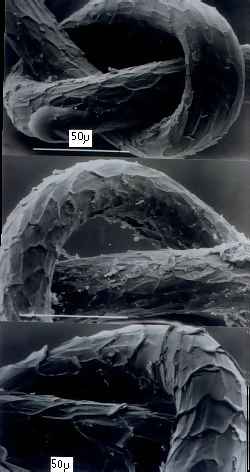 The scanning electron micrograph shows the outer hair structure to be an even pattern of overlapping scales. Sheeps' wool comprises two ore three layers of scales. For mordant salts and dyestuffs this outer layer represents the first barrier on their way interior of the hair. The effect of the Geotrichum yeast spores on the hair structure is now apparent. The scale layers of the wool hair exfoliated to a clearly visible extent proportionate to the immersion time of the wool yarns in the fermentation solution.
The scanning electron micrograph shows the outer hair structure to be an even pattern of overlapping scales. Sheeps' wool comprises two ore three layers of scales. For mordant salts and dyestuffs this outer layer represents the first barrier on their way interior of the hair. The effect of the Geotrichum yeast spores on the hair structure is now apparent. The scale layers of the wool hair exfoliated to a clearly visible extent proportionate to the immersion time of the wool yarns in the fermentation solution.
This procedure is characterised by high enzyme activity of the Geotrichum, which results in a decomposition of fatty substances between the scale layers. The diffusion of mordant salts and dyestuffs into the inner hair cortex is considerably faciliated by this.
Picture above: madder-dyed wool hair, no fermentation. Center Picture: madder-dyed wool hair, 7 days fermentation. Picture below: madder-dyed wool hair, 20 days fermentation.
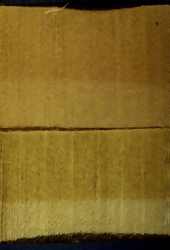
The properties of the wool yarn are not changed by the fermentation process described, whereas the binding capability of the natural dyestuff to the wool fibre is coniderably enhanced. This effect can be proved by means of an endurance test under direct sunlight.
The picture on the left shows yellow dyeing on wool with Rhamnus petiolaris proved by a one year endurance test under direct sunlight in Istanbul 1984.
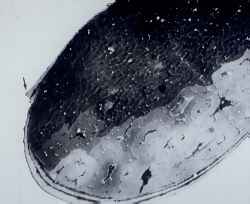 The photograph on the right shows the section of a 0.04 mm thick, fermented wool hair viewed through a scanning electron microscope at 5000-fold magnification after fixing by means of osmium acid and contrasting by means of heavy metal salts. In the left half of the photgraph, the cuticula-exfoliation from the hair cortex can be seen - marked by arrows. This can be ascribed to the above mentioned effects of fermentation. The hair cortex itself is noticeably divided into two sections: a darker section, the keratin fibres are systematically ordered in the form of bundles, whereas in the lower section, the fibres are arranged more randomly. The spaces between the fibres, which represent the cell interstices in the growing hair, are filled by a matrix.
The photograph on the right shows the section of a 0.04 mm thick, fermented wool hair viewed through a scanning electron microscope at 5000-fold magnification after fixing by means of osmium acid and contrasting by means of heavy metal salts. In the left half of the photgraph, the cuticula-exfoliation from the hair cortex can be seen - marked by arrows. This can be ascribed to the above mentioned effects of fermentation. The hair cortex itself is noticeably divided into two sections: a darker section, the keratin fibres are systematically ordered in the form of bundles, whereas in the lower section, the fibres are arranged more randomly. The spaces between the fibres, which represent the cell interstices in the growing hair, are filled by a matrix.
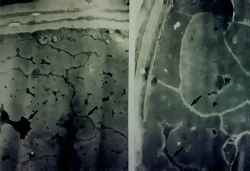 During the preparation process for electronmicroscopic examination, it is the matrix of the fermented wool hair (left side) which is coloured in intense black. This phenonemon can be traced back to an increased metal ion concentration. The results suggest that with the fermented wool hair, mordants can more easily penetrate into the interior of the hair, this being made possible by the exfoliation of the outer scale layers. Neither the wool fibres nor the matrix of the wool hair is structurally changed by this fermentation process.
During the preparation process for electronmicroscopic examination, it is the matrix of the fermented wool hair (left side) which is coloured in intense black. This phenonemon can be traced back to an increased metal ion concentration. The results suggest that with the fermented wool hair, mordants can more easily penetrate into the interior of the hair, this being made possible by the exfoliation of the outer scale layers. Neither the wool fibres nor the matrix of the wool hair is structurally changed by this fermentation process.
Application of the results to the hair structure of antique Anatolian carpets and flatweaves.
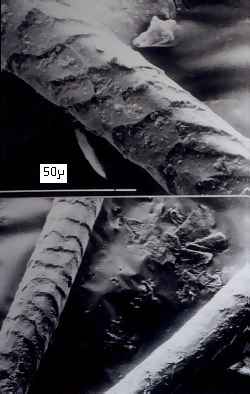 Technological procedures leave traces on material processed.
Technological procedures leave traces on material processed.
Assuming that the hypothesis to be true that fermentation methodology lies behind handed-down dyeing techniques in the Anatolian region, tests with antique carpets and flatweaves should lead to reproducible results, as already illustrated in detail under point one and two. However results obtained from first samples were hardly encouraging, since the outer cuticula of most of the wool hair was in most cases missing. Incidentally, this is the reason for the silky surface of antique textiles.
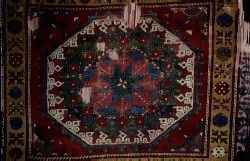 A systematic series of tests carried out on notted carpets and flatweaves from the most important Anatolian manufacturing regions finally resulted in a significant overall survey of traditional dyeing procedures. The picture on the right shows a large pattern Holbein-Carpet, 16th century (Türk ve Islam Eser Müzesi Istanbul)
A systematic series of tests carried out on notted carpets and flatweaves from the most important Anatolian manufacturing regions finally resulted in a significant overall survey of traditional dyeing procedures. The picture on the right shows a large pattern Holbein-Carpet, 16th century (Türk ve Islam Eser Müzesi Istanbul)
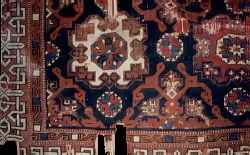
The scanning electron micrographs taken of dyed wool hair from Ushak carpets in Berlin museum of Islamic Art showed a high degree of conformity regarding the exfoliation of the outer scale layer.
The picture on the left shows a small pattern Holbein-Carpet, 16th century (Türk ve Islam Eser Müzesi Istanbul).
In contrast to this, wool samples taken from the warp of the same carpets showed typical characteristics in non-fermented wool, i.e. closed scale layers.
Exfoliation caused by fermentation was also detected in carpets from other manufacturing region. For example wool samples taken from a 16th century Aksaray carpet also showed a typical fermentation effect.
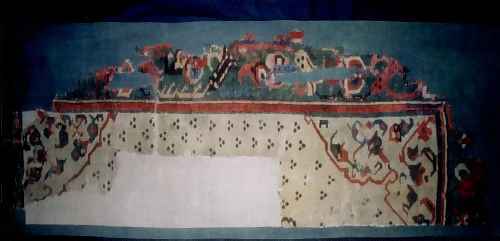 Aksaray-Carpet, 16. Century
Aksaray-Carpet, 16. Century
Summary
Scanning microscope stdies carried out on wool hair from Anatolian carpets and flatweaves dating from the 16th to the 19th century documented a highly significant conformity in the hair structure, which can only be achieved by fermentation. Thus, this technological concept is directly connected with a dyeing procedure as discribed by Moshkova for the carpet manufacturing Turkic peoples of Central Asia. They are not the result of a convergent development but rather document the migration of traditional arts and crafts to another cultural area.
In addition to this, the expedition reports by V.G. Moshkova furnish valuable information on the procedure during the actual dyeing process. Several sections of her reports refer to so-called cold dyeing technique. This procedure suggests an economic practice enabling the user to do without percious energy sources. However, the handling of such processes implies acid-stable dye baths, which prevent the wool yarn from rotting and guarantee good dyeing results.
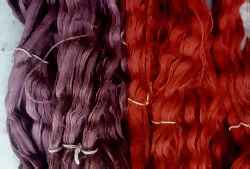 The striking success of colddyeing can be most effectively demonstrated in the production of purple-coloured wool yarns. In order to be able to achieve purple colour shades it is of particular importance that the mordant and the dye bath temperature does not exceed 40°C. Following a pre-mordant bath of 2 to 10% concentration of green iron sulphate the yarns are placed in suspension of madder, wheat bran and sourdough. After aproximatiliy 5 to 6 days at an ambient temperature of 30°C the fermentation process is terminated. The wools, which are now medium to dark brown, are further treated in a solution of potash for 2 days at the same ambient temperature, thus producing the colour purple.
The striking success of colddyeing can be most effectively demonstrated in the production of purple-coloured wool yarns. In order to be able to achieve purple colour shades it is of particular importance that the mordant and the dye bath temperature does not exceed 40°C. Following a pre-mordant bath of 2 to 10% concentration of green iron sulphate the yarns are placed in suspension of madder, wheat bran and sourdough. After aproximatiliy 5 to 6 days at an ambient temperature of 30°C the fermentation process is terminated. The wools, which are now medium to dark brown, are further treated in a solution of potash for 2 days at the same ambient temperature, thus producing the colour purple.
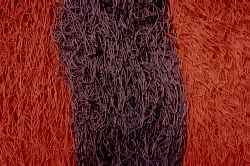 The success of dyeing process strongly depends on the temperature, since the purple-specific dyestuff Pseudopurpurin is converted in Purpurin at the boiling point, which then makes a clear purple impossible.
The success of dyeing process strongly depends on the temperature, since the purple-specific dyestuff Pseudopurpurin is converted in Purpurin at the boiling point, which then makes a clear purple impossible.
However, the procedure cannot be used to dye silk purple. Here the process is carried out using the traditional alum mordant together with carminic acid extracts of cochineal.
When further nuancing the material in copperas baths and a solution of potash, the predyed carmine colour changes into brilliant purple.
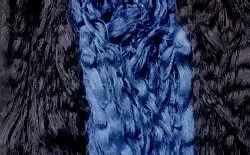 In a modified form, the cold dyeing process can also be used for the manufacture of black-dyed wool yarns. The process is as for purple dyeing using indigo pre-dyed wool yarns to achieve blackish-blue to deep black. This method would have helped to eliminate the tiresome problem of corrosive wool destruction. In former times, manufacturers of carpets and flatweaves were familiar with this phenomenon, which is manifested in the small number of products with a black background.
In a modified form, the cold dyeing process can also be used for the manufacture of black-dyed wool yarns. The process is as for purple dyeing using indigo pre-dyed wool yarns to achieve blackish-blue to deep black. This method would have helped to eliminate the tiresome problem of corrosive wool destruction. In former times, manufacturers of carpets and flatweaves were familiar with this phenomenon, which is manifested in the small number of products with a black background.
A comparative examination of colour analyses carried out on more than 100 Anatolian carpets dating from the 19th century revealed interesting indications of multiple use of a single dye bath. Up to 35% of the wool samples with yellow colours showed traces of madder dyestuffs. These results suggest that experienced dyers were well aware of the value of the dye bath and therefore used them several times over. This method resulted in considerable savings in natural resources.
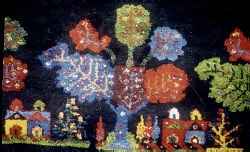 The picture on the left shows the black ground reconstruction of the red ground Kirsehir-Carpet from the Victoria and Albert Museum/London.
The picture on the left shows the black ground reconstruction of the red ground Kirsehir-Carpet from the Victoria and Albert Museum/London.
Eine vergleichende Untersuchung an Farbanalysen von mehr als 100 anatolischen Knüpfteppichen des 19.Jahrhunderts lieferte interessante Hinweise auf den mehrfachen Gebrauch einer einzigen Färbeflotte. Maximal 35% der analysierten Wollproben zeigten bei Gelbfärbungen Spuren der Farbstoffe von Krapp.
Diese Ergebnisse lassen den Rückschluß zu, daß geübte Färber sehr wohl den Wert der Färbebäder kannten und diese auch mehrfach benutzten. Dieses methodische Konzept ließ den wiederholten Einsatz einer einzigen Färbeflotte zu und führte zu einer erheblichen Einsparung von Naturstoffen.
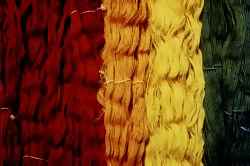 The manufacture of a large sized Ushak carpet required, for example 20 to 25 kilograms of red-dyed wool yarns. In order to be able to achieve satisfying dyeing results, an equal quantity of madder and an 800-litre dyeing vat had to be used. In a large scale trial it was found that it was possible to dye another batch in the same dye bath. Adding plants giving yellow dyes to the same dye bath than resulted in orange and yellow colours, whereas wool yarns pre-dyed with indigo turned a shade of green. The overall outcome with this economical concept is a saving in the dye bath of more than 3000 litres.
The manufacture of a large sized Ushak carpet required, for example 20 to 25 kilograms of red-dyed wool yarns. In order to be able to achieve satisfying dyeing results, an equal quantity of madder and an 800-litre dyeing vat had to be used. In a large scale trial it was found that it was possible to dye another batch in the same dye bath. Adding plants giving yellow dyes to the same dye bath than resulted in orange and yellow colours, whereas wool yarns pre-dyed with indigo turned a shade of green. The overall outcome with this economical concept is a saving in the dye bath of more than 3000 litres.
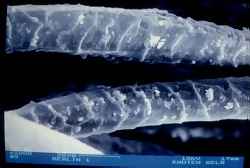 Holbein-Carpet, 16th century, yellow wool hair.
Holbein-Carpet, 16th century, yellow wool hair.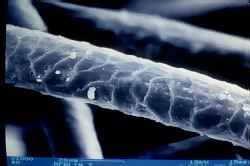 Lotto-Carpet, 16th century, yellow wool hair.
Lotto-Carpet, 16th century, yellow wool hair.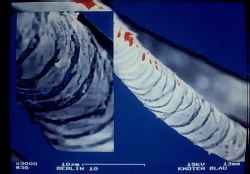 Star-Ushak, 17th century, blue wool hair.
Star-Ushak, 17th century, blue wool hair.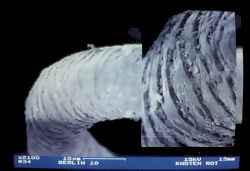 Star-Ushak, 17th century, red wool hair.
Star-Ushak, 17th century, red wool hair.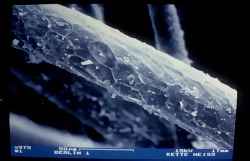 White warp wool-hair from a Ushak-Carpet, 16th century.
White warp wool-hair from a Ushak-Carpet, 16th century.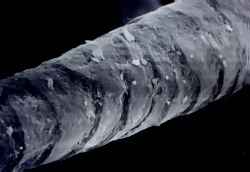 Red wool hair taken from the above Aksaray-Carpet.
Red wool hair taken from the above Aksaray-Carpet.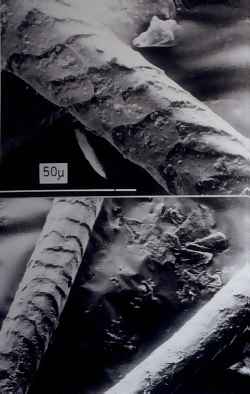 Scanning electron micrographs of wool samples from a Konya bag face and a Yüncü flatweave revealed comparable results.
Scanning electron micrographs of wool samples from a Konya bag face and a Yüncü flatweave revealed comparable results.
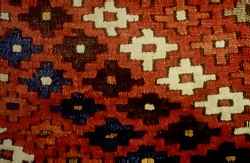 Konya bagface, 19th century
Konya bagface, 19th century
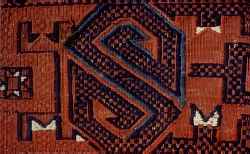 Yüncü flatweave, 19th century
Yüncü flatweave, 19th century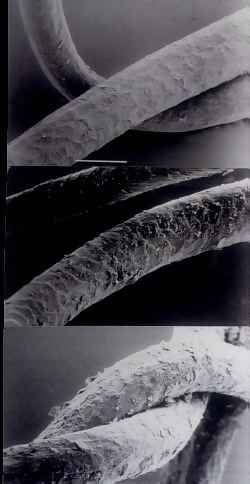 The fermentation influence was also detected in the wools of a 17th century "Chessboard" carpet. While the warp did not show any scale exfoliation, the cuticula of madder-dyed yarns was noticeably angled away from the cortex.
The fermentation influence was also detected in the wools of a 17th century "Chessboard" carpet. While the warp did not show any scale exfoliation, the cuticula of madder-dyed yarns was noticeably angled away from the cortex.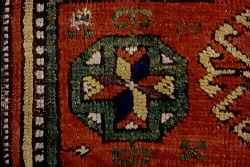 Village carpet, Konya region, 19th century.
Village carpet, Konya region, 19th century.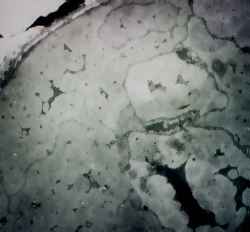 The verification of findings obtained so far of sections of red-dyed pile wool from a 17th century Ushak carpet and a 19th century village carpet from the Konya region showed an increased contrast in the matrix in both cases as was already proved with fermentated wools.
The verification of findings obtained so far of sections of red-dyed pile wool from a 17th century Ushak carpet and a 19th century village carpet from the Konya region showed an increased contrast in the matrix in both cases as was already proved with fermentated wools.